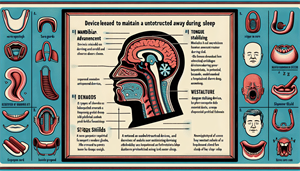
What Is a Snore Guard?
A snore guard is a device designed to reduce snoring by keeping your airway open at night. In this article, we’ll explore the functioning of snore guards, the available options, and their practical impact on sleep for both snorers and their partners.
Key Takeaways
Snore guards are dental devices that address ‘mouth snoring’ by maintaining an open airway during sleep through shifting the lower jaw forward and preventing the tongue from blocking the airway, thus reducing or eliminating snoring.
Various types of snore guards exist, including mandibular advancement devices (MADs), tongue-retaining devices (TRDs), custom-fitted, and boil-and-bite models, each offering different features to accommodate specific needs and preferences.
Snore guards can help with obstructive sleep apnea (OSA) by keeping the airway open, serving as an alternative to CPAP machines for some individuals.
Professional consultation is recommended to diagnose snoring-related sleep disorders and to ensure proper fit, effectiveness, and maintenance of the device.
Understanding Snore Guards: Definition and Purpose
Snore guards, dental devices designed for snoring and teeth grinding, function by maintaining an open airway during sleep. They typically consist of two interconnected plastic trays tailored to suit the user’s mouth. They operate by gently shifting the lower jaw forward, preventing the tongue from falling back into the throat and obstructing the airway, ultimately reducing or even eliminating snoring. Specifically, they inhibit the vibration of the throat and soft tissue muscles when air passes through them, a common cause of snoring sounds, thus addressing ‘mouth snoring’.
Snore Guard Basics
By gently advancing the lower jaw, snore guards enhance airflow through the upper airway and throat, thereby assisting in preventing snoring. They are composed of two polycarbonate thermoplastics that have been fused together, designed to comfortably fit over the upper and lower teeth. There are various designs of snore guards aimed at preventing snoring.
An example of this is an anti-snoring brace, which is a bow-shaped device covered in silicone. This type of product is designed to help reduce snoring during sleep. Placed at the back of the mouth, it applies gentle pressure to the palatal arch, helping to reduce mouth snoring.
The Purpose of a Snore Guard
A snore guard serves to reduce snoring, improve sleep quality for the user and their partner, prevent the collapse and obstruction of the throat’s soft tissues, maintain an open airway during sleep, lead to a more restful and uninterrupted sleep experience, and reduce snoring sounds. Snore guards, a type of anti snoring device, are an effective way to stop snoring, prevent snoring, and eliminate snoring, improving sleep quality.
Not only can snore guards improve the sleep quality of the user, but they can also positively affect the sleep quality of bed partners of individuals who snore by mitigating snoring sounds and promoting a quieter sleep environment.
Types of Snore Guards: Finding the Right Fit for You
There are various types of snore guards, each tailored to accommodate different needs and preferences. Some common types include:
-
Mandibular advancement devices (MADs): These devices shift the lower jaw forward to keep the airway open.
-
Tongue-retaining devices (TRDs): These devices hold the tongue in place to prevent it from blocking the airway.
-
Custom-fitted snore guards: These are made specifically for your mouth and provide a comfortable fit.
-
Boil-and-bite snore guards: These can be molded to fit your mouth by boiling them and then biting down.


